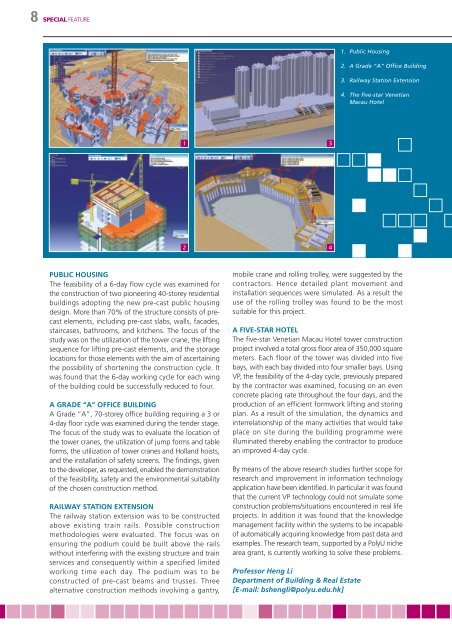Issue No. 3 (November 2006) - The Hong Kong Polytechnic University
Issue No. 3 (November 2006) - The Hong Kong Polytechnic University
Issue No. 3 (November 2006) - The Hong Kong Polytechnic University
You also want an ePaper? Increase the reach of your titles
YUMPU automatically turns print PDFs into web optimized ePapers that Google loves.
8<br />
SPECIAL FEATURE<br />
1. Public Housing<br />
2. A Grade “A” Office Building<br />
3. Railway Station Extension<br />
4. <strong>The</strong> five-star Venetian<br />
Macau Hotel<br />
1<br />
3<br />
2 4<br />
PUBLIC HOUSING<br />
<strong>The</strong> feasibility of a 6-day flow cycle was examined for<br />
the construction of two pioneering 40-storey residential<br />
buildings adopting the new pre-cast public housing<br />
design. More than 70% of the structure consists of precast<br />
elements, including pre-cast slabs, walls, facades,<br />
staircases, bathrooms, and kitchens. <strong>The</strong> focus of the<br />
study was on the utilization of the tower crane, the lifting<br />
sequence for lifting pre-cast elements, and the storage<br />
locations for those elements with the aim of ascertaining<br />
the possibility of shortening the construction cycle. It<br />
was found that the 6-day working cycle for each wing<br />
of the building could be successfully reduced to four.<br />
A GRADE “A” OFFICE BUILDING<br />
A Grade “A”, 70-storey office building requiring a 3 or<br />
4-day floor cycle was examined during the tender stage.<br />
<strong>The</strong> focus of the study was to evaluate the location of<br />
the tower cranes, the utilization of jump forms and table<br />
forms, the utilization of tower cranes and Holland hoists,<br />
and the installation of safety screens. <strong>The</strong> findings, given<br />
to the developer, as requested, enabled the demonstration<br />
of the feasibility, safety and the environmental suitability<br />
of the chosen construction method.<br />
RAILWAY STATION EXTENSION<br />
<strong>The</strong> railway station extension was to be constructed<br />
above existing train rails. Possible construction<br />
methodologies were evaluated. <strong>The</strong> focus was on<br />
ensuring the podium could be built above the rails<br />
without interfering with the existing structure and train<br />
services and consequently within a specified limited<br />
working time each day. <strong>The</strong> podium was to be<br />
constructed of pre-cast beams and trusses. Three<br />
alternative construction methods involving a gantry,<br />
mobile crane and rolling trolley, were suggested by the<br />
contractors. Hence detailed plant movement and<br />
installation sequences were simulated. As a result the<br />
use of the rolling trolley was found to be the most<br />
suitable for this project.<br />
A FIVE-STAR HOTEL<br />
<strong>The</strong> five-star Venetian Macau Hotel tower construction<br />
project involved a total gross floor area of 350,000 square<br />
meters. Each floor of the tower was divided into five<br />
bays, with each bay divided into four smaller bays. Using<br />
VP, the feasibility of the 4-day cycle, previously prepared<br />
by the contractor was examined, focusing on an even<br />
concrete placing rate throughout the four days, and the<br />
production of an efficient formwork lifting and storing<br />
plan. As a result of the simulation, the dynamics and<br />
interrelationship of the many activities that would take<br />
place on site during the building programme were<br />
illuminated thereby enabling the contractor to produce<br />
an improved 4-day cycle.<br />
By means of the above research studies further scope for<br />
research and improvement in information technology<br />
application have been identified. In particular it was found<br />
that the current VP technology could not simulate some<br />
construction problems/situations encountered in real life<br />
projects. In addition it was found that the knowledge<br />
management facility within the systems to be incapable<br />
of automatically acquiring knowledge from past data and<br />
examples. <strong>The</strong> research team, supported by a PolyU niche<br />
area grant, is currently working to solve these problems.<br />
Professor Heng Li<br />
Department of Building & Real Estate<br />
[E-mail: bshengli@polyu.edu.hk]

















